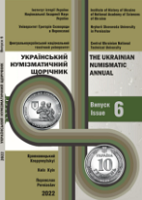НОВІ ЗНАХІДКИ СКАНДИНАВСЬКИХ МОНЕТ ІХ–ХІ СТОЛІТЬ НА ТЕРИТОРІЇ УКРАЇНИ
NEW FINDINGS OF SCANDINAVIAN COINS IX–XI CENTURIES AT THE TERRITORY OF UKRAINE
Author(s): Serhii Kuleshov, Victor Petrovich KotsurSubject(s): Archaeology, Cultural history, Economic history, 6th to 12th Centuries
Published by: ДВНЗ Переяслав-Хмельницький державний педагогічний університет імені Григорія Сковороди
Keywords: Ukraine; Kievan Rus; findings; Western European denarii; Scandinavian denarius;
Summary/Abstract: The aim of the study – is presentation of a new findings of Scandinavian coins ІХ–ХІ centuries at the territory of Ukraine. The article is a continuation of the research presented in the article "New finds of Scandinavian coins of the ІХ–ХІ centuries at the territory of Ukraine", published in 2020. Research methodology – principles of historicism, generalization, historical-typological, comparative analyzis. Scientific novelty. Author is using information published at the Violiti auction forum site to study finding of Western European denarii in Ukraine. Violiti auction forum is the specific site to post images of findings coins for their attribution. The article is a continuation of the research taking place in the publication "New findings of Scandinavian coins IX–XI centuries at the territory of Ukraine" (No 4. 2020): The Ukrainian Numismatic Annual). Half-bracteate (No 1) is among the finds of early Danish coins and belongs to the "second row" of the first Danish coins. It was struck during the reign of king Harald Bluetooth (ruled 958–987). This is the fourth registered case of half-bracteate finds in Ukraine. We discussed the first two finds (Kyiv region) in the previous article. Also, the fragment of the similar half-bracteate is a piece of the Andrushyvka village treasure (Zhytomyr region). P. Hauberg dates coins to 940–960 AD. Later Britt Malmer attributed similar coin types to 975–980. The minting place is also not ascertained. It is either Yelling, Roskilde, or Lund. Denarius (No 2) was minted by Danish king Hardeknud (ruled 1018–1042). It is an imitation of the Cnut the Great English penny of "Helmet" type. This is the third coin of this king found in Ukraine. Same type Danish coins (No 3; 4; 5) were minted by king Svend II Estridsen (ruled 1047–1074). Numbers 3 and 4 are similar. Coin No. 5 attracts attention with slightly different image on the obverse – small head is on the right side (not as usual on left), and the big head is turned right, not left. Between heads is the image of a cross. Among three Swedish coins (No 7–9) there are unusual No 7 and No 9 artifacts. Coin No 7 is a combined type with image of a short cross on one side and long cross – on another side of the coin. This is not typical for Æthelred‘s II the Unready penny imitations minted by king Olaf Scotking (r. 995–1022). Coin No 8 represents this imitation type. Denarius No 9 is an imitation of the English king Æthelred‘s II the Unready "Agnus Dei" penny with the image of the Lamb of God on the obverse. On the reverse – the image of a cross with four balls in the corners – duplication of the Knuth the Great penny ―Pointed Helmet‖ reverse. Britt Malmer indites that the mentioned coins should be attributed to the period 1023–1030 when the original ―Pointed Helmet‖ coins was minted. According to her classification ‗1020–1030‘ is the III period (namely from 1023) of the Swedish coins mint, which fits the reign of king Anund Jakob (ruled 1022–1050). Denarius No. 9 is the third recorded find of king Anund Jakob coin at Ukraine territory. Coiin No 10 is Denarius of the Irish king Sihtric III Olavsson (reigned 995–1036) are rare find in Ukraine. This coin, found in Volyn region in almost perfect condition, was described at our publication. It is the same kind of Æthelred II the Unready "large cross" type coin imitations that was described at publication (No. 10). There are problems with these items time dating. Some authors believe that coins belong to the Phase I of imitations and were struck between 1000 and 1018. It is argument by the presence of monetarius Firemen name. Other struck of these imitations belong to the Phase II between 1018 and 1035. Copper coin No 11 we quite conditionally denote as Scandinavian. Æthelred‘s II the Unready penny, like other Western European denarii, was widely circulated in Kievan Rus at the first half of the 11th century. This led to an influx of both quality and counterfeit imitating of the penny. It is even possible that some were anufactured at the territory of Kievan Rus. However, the character of King‘s bust depiction and the long cross bring it closer to Scandinavian mint. That time copper Swedish coins also were present at circulation according to Britt Malmer. The Conclusions. Thus, author concludes, we can state Scandinavian coins presence in southern part of Kievan Rus monetary circulation. Total number of coins minted in Scandinavia was insignificant compared to coins minted at other Western European states. This may indirectly indicate high level of Western European denarii usage intensity as means of payment in Ukrainian territories of those times. Some data show that such denarii were in circulation in southern Russia in the third quarter of the XI century. This is evidenced by the findings of the coins of the Danish King Sven Estridsen, whose reign dates to this very time. It should be noted that the presence of coins of the first half of the XI century with denarius of the third quarter of this century is not so frivolous. This, in our opinion, increases the time period of circulation of Western European denars on historical Ukrainian lands until the beginning of the XII century.
Journal: Український Нумізматичний Щорічник
- Issue Year: 2022
- Issue No: 6
- Page Range: 198-205
- Page Count: 8
- Language: Ukrainian

